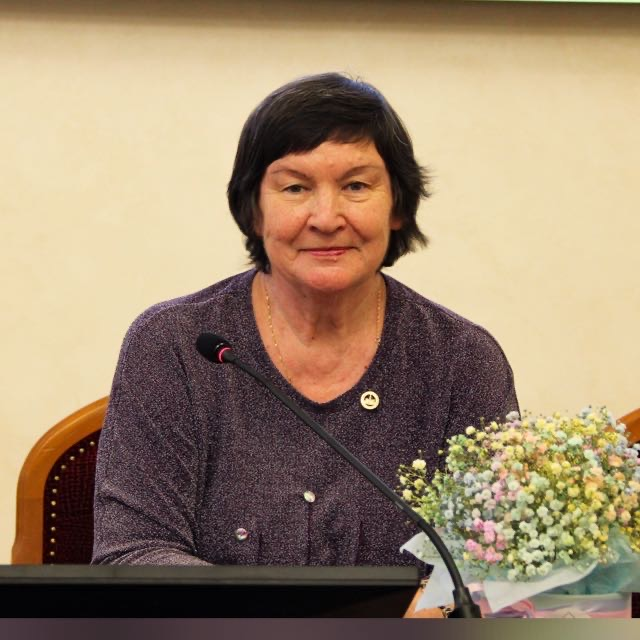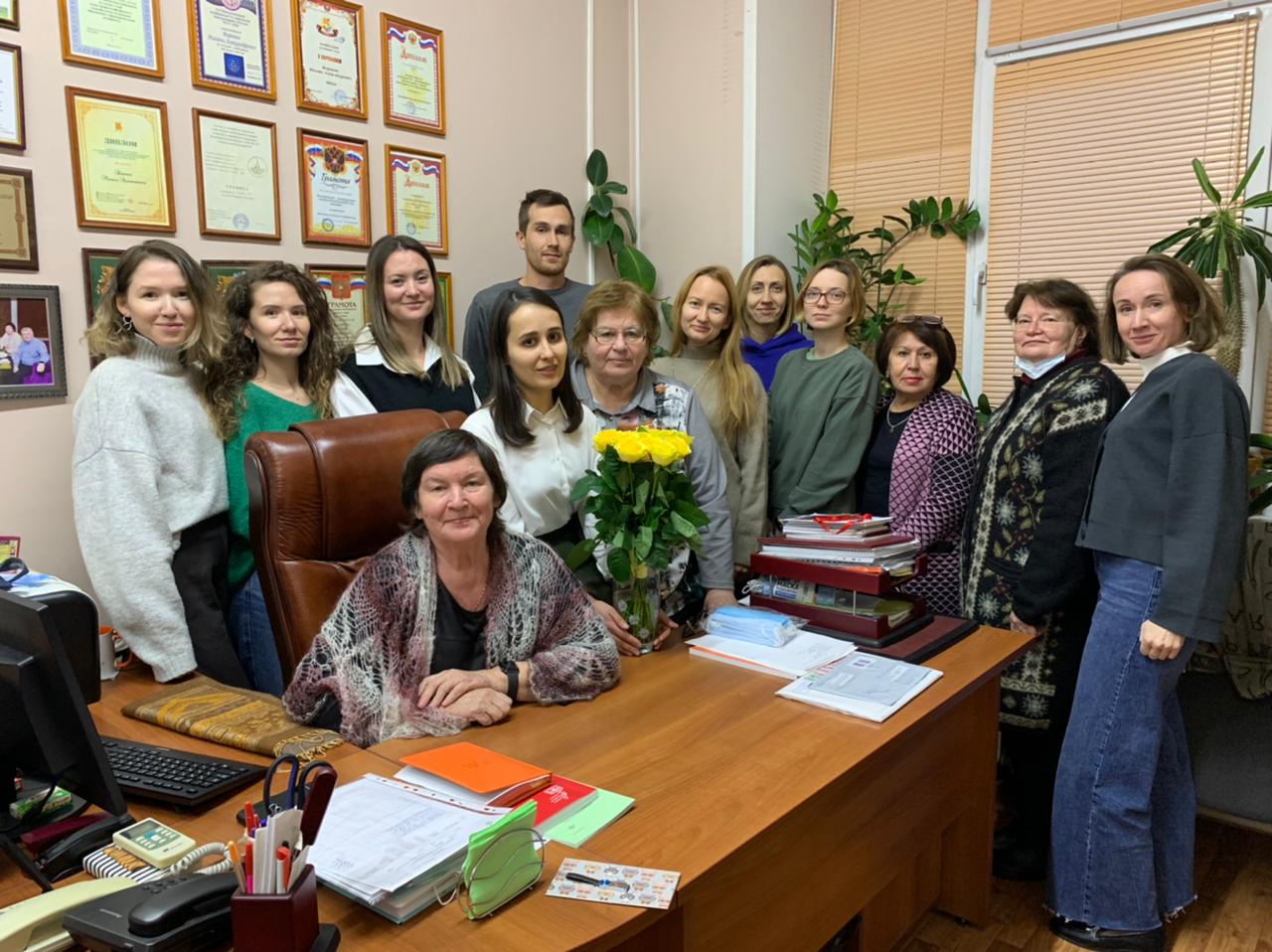Laboratory of highly organized structures
The Laboratory of Highly Organized Structures was created on the base of the group under the supervision of Dr. L.A. Kudryavtseva in 2000. Since 2008 the Laboratory is headed by Professor Lucia Ya. Zakharova.

Head of Laboratory
Full Professor, Dr. Lucia Zakharova
Phone number (843) 273-22-93
Room 306
Email lucia@iopc.ru, luciaz@mail.ru
Deputy Head of the Laboratory
Senior Researcher, PhD Alla Mirgorodskaya
Phone number (843) 273-22-93
Room 311
Email mirgorod@iopc.ru
Members and postgraduates
Senior Researcher, PhD Gulnara Gaynanova
Senior Researcher, PhD Elena Zhiltsova
Senior Researcher, PhD Ruslan Kashapov
Senior Researcher, PhD Sergey Filippov
Senior Researcher, PhD Elmira Vasilieva
Researcher, PhD Farida Valeeva

History of the laboratory's development
Laboratory of Highly Organized Structures (LHOS) is historically related to Laboratory of Organophosphorus Polymers (LOPP) under the leadership of Professor B.E. Ivanov, one of the largest and oldest laboratories of the A.E. Arbuzov Institute of Organic and Physical Chemistry (IOPC). Over 1975-1985 period, the laboratory staff comprised over 80 people and gathered leading scientific groups that carried out research on the tasks of the Presidium of the Academy of Sciences of the USSR. Eventually some of these research teams of LOPP branched out into independent laboratories headed by Professor V.S. Reznik, Professor Ya.A. Levin, Professor I.A. Nuretdinov. In 1996 the group of LHOS was separated and taken under the leadership of Dr. L.A. Kudryavtseva. At that time the main focus of the laboratory work was the study of influence of the solvents as well as micellar systems on the rate of nucleophilic substitution reactions of phosphorus acid esters. Dr. V.E. Belskiy and Dr. S.B. Fedorov played a central role in the evolution of laboratory and its creative development. Since 2008 the Laboratory is headed by Professor Lucia Ya. Zakharova.
Research trends
- The main research direction of the LHOS is the development of self-assembly strategies of the design of polyfunctional nanosystems with enhanced properties (catalysis, solubilization, anticorrosion and antimicrobial activity) based on the key “bottom-up” principle of supramolecular chemistry, i.e. non-covalent self-organization of surfactants, cyclophanes, and polymers. One of the priority research lines in the LHOS concerns specifically the formation of nanosized containers and polyelectrolyte capsules for organic and biological substrates in order to identify the factors controlling substrate reactivity, preservation, concentration and biotransport. A new approach to encapsulate hydrophobic (uncharged) substrates was developed using layer-by-layer technology allowing obtaining of micro- and nanocapsules with substrate binding and release properties. Recently the laboratory activity has been concerned with the solution of fundamental problems in medical chemistry, pharmacology, and nanoengineering. From this point of view, our research interest includes the investigation of the novel supramolecular systems that sensitive to external stimuli and capable to effectively interact with cell membranes.
- The achievement of the goals stated assumes a systematic study of self-assembly of individual amphiphilic compounds and their mixed systems, including their synthesis as a tool for progressive variation of the building block structure. This approach allows us to go from screening to the directed design of functional systems based on established regularities.
- Biomimetic nature of supramolecular systems allows us to solve the high-priority problems of the biotechnological applications: the formation of nanocontainers, micro- and nanocapsules for storage and delivery of therapeutic agents including water-insoluble drugs, DNA, diagnostic probes.
- Conventional direction of investigations in laboratory is fabrication of supramolecular catalytic systems using the strategy of amphiphilic compounds self-assembly for decontamination of toxic esters of phosphorus acids, acetylcholinesterase inhibitors. Collected results allows to design effective nanoreactors based on cationic surfactants, polymers, macrocycles and metal ions. It provides catalytic activity up to six and more orders of magnitude, specificity and producibility of process due to combined contribution of micellar and homogeneous catalysis, as well as immobilization of nanoreactors on polymer or inorganic template
- Laboratory pays much attention to the collaboration with research groups working in the key areas of regional science associated with oil extraction and processing. The experience gained and knowledge of the tendency in changes of properties of surfactants in condensed state makes it possible to design the inhibitors of corrosion - bactericides for the protection of oil field equipment and viscoelastic compositions for increasing oil recovery, etc.
Important results of laboratory as a part of achievements of Arbuzov IOPC, FRC Kazan Scientific Center of RAS
- 2017 year:
1. For the first time ever lipid nanocontainers for quaternized oximes capable to pass across blood-brain barrier have been designed. Due to the high encapsulation effectiveness of the drug (pralidoxime chloride) 15 % of acetylcholinesterase reactivation in the brain has been reached. It allows to 2-fold increase of the survival rate of rats after poisoning by lethal dose of paraoxone - wide used in the world pesticide. It is the world first successful result in the field of the therapy of the poisoning of cholinesterases by organophosphorus inhibitors using nanocontainers.
2. For the first time ever for homologous series of imidazolium-containing amphiphiles nonconventional mechanism of the influence of hydrophobicity on functional activity, differing from typical behavior of surfactant solutions (correlation between properties and the length of alkyl tails), has been exhibited. Qualitative binding of DNA decamer by all homologues, levelling of the hydrophobicity effect on solubilization power of micelles, as well as the ability of only lower homologues to integrate with lipid bilayer increasing of its permeability for drugs have been exhibited. Results obtained increases biotechnological potential of supramolecular systems.
- 2018 year:
New multifunctional biocompatible nanocontainers for hydrophobic drugs (quercetin, rutin, furadonin) and DNA have been developed based on complexes of Cu (II), Ni (II), Co (II), La (III) and cationic surfactants with a bicyclic head group. It has been established that their high bactericidal and fungicidal activity exceeds the activity of norfloxacin and ketoconazole by more than 8 times.
- 2019 year:
With the aim of targeted delivery of drugs into mitochondria, new stable cationic liposomes were obtained by non-covalent inclusion of imidazolium and triphenylphosphonium surfactants into the lipid bilayer. A higher degree of colocalization of cationic liposomes with mitochondria in comparison with unmodified analogs was proved by confocal microscopy. The modified liposomes exhibit stability for several months, improved encapsulation efficiency, prolonged release of drug compounds, and high cytotoxicity against PANC-1 pancreatic carcinoma cells.
- 2020 year:
For the first time, a successful in vivo application of cationic liposomes non-covalently modified with synthetic gemini surfactants for the reactivation of cerebral acetylcholinesterase after poisoning with organophosphorus compounds by intravenous administration of the antidote pralidoxime chloride (2-PAM) was carried out. The developed liposomal form made it possible to eliminate the established intravenous limitations associated with high toxicity and hemagglutination caused by cationic liposomes, and to achieve 27% reactivation of brain acetylcholinesterase.
- 2021 year:
1. New micellar compositions based on hydroxypiperidinium surfactants have been obtained that have multifunctional activity as (1) biomimetic nanoreactors of selective action for the concentration and decomposition of toxic organophosphorus compounds, carboxylic acid esters and polyaromatic pollutants; (2) antimicrobial agents active both against pathogenic strains of animals and plants; (3) adjuvants that increase the efficiency of surface wetting and increase the transport of agrochemicals into the plant. A wide range of practical properties is due to the high solubilizing ability of hydroxypiperidinium surfactants and membranotropic properties.
2. New mitochondria-targeted nanocontainers of two types have been obtained: liposomal formulations and nanocomposite systems based on mesoporous silica nanoparticles non-covalently modified with cationic surfactants. It was shown for the first time that not only triphenylphosphonium, but also imidazolium cations are capable of imparting targeting properties to cell mitochondria. According to confocal microscopy data, modification of liposomal systems makes it possible to increase their accumulation in mitochondria up to 30%.
Selected Publications
Grants Support
Collaborations with other Institutes and Centers
- Kazan National Research Technological University
- Kazan (Volga region) Federal University
- Kazan Institute of Biochemistry and Biophysics of Kazan Scientific Center of the Russian Academy of Sciences
-
V. Zelman Institute for Medicine and Psychology, Novosibirsk State University
- L.M. Litvinenko Institute of Physical-Organic Chemistry and Coal Chemistry of National Academy of Sciences of Ukraine (Donetsk)
- University College London, School of Pharmacy (United Kingdom)
- University of Reading (United Kingdom)
- Institute of pharmacy Kazan State Medical University
- D. Mendeleev University of Chemical Technology of Russia
- Shemyakin-Ovchinnikov Institute of Bioorganic Chemistry
- Kazan National Research Technical University named after A. N. Tupolev - KAI
-
Lipoid GmbH
- Phospholipid Research Center, Heidelberg, Germany
- JSC «August» Inc.
International Collaborations
- Karpichev Yevgen (h-èíäåêñ 16), Kapitanov Illia (h-èíäåêñ 8) - Department of Chemistry, Chair of Green Chemistry, Tallinn University of Technology, Academia tee 15, 12618 Tallinn, Estonia.
- Prof. Vitaliy V. Khutoryanskiy -School of Pharmacy, University of Reading, United Kingdom, h-èíäåêñ 39.
- Prof. Ijeoma F. Uchegbu, School of Pharmacy, University College London, United Kingdom, h-èíäåêñ 43.
- Prof. Eliana B. Souto, Department of Pharmaceutical Technology, Faculty of Pharmacy, University of Coimbra, Coimbra, Portugal, h-èíäåêñ 56.
